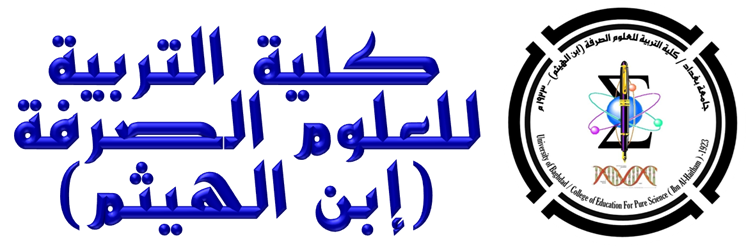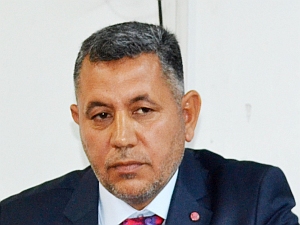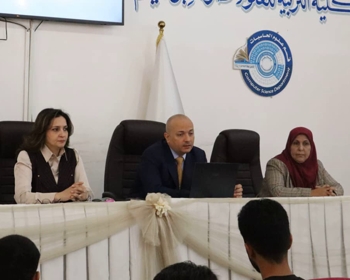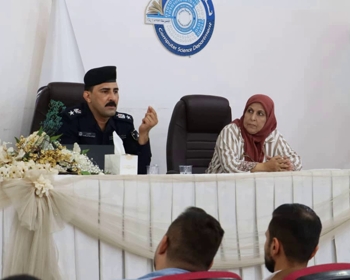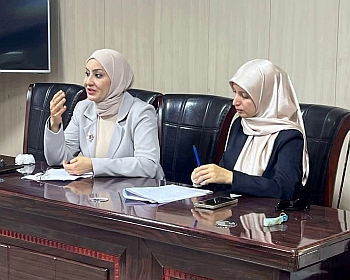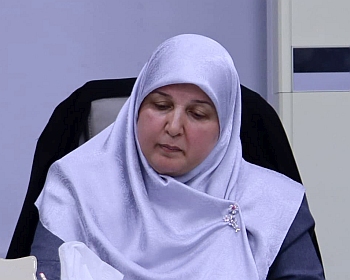ناقش قسم علوم الحياة في كلية التربية للعلوم الصرفة ( ابن الهيثم ) اطروحة الدكتوراه الموسومة ( لتغيرات الفصلية لمجتمع الطحالب في النظام البيئي المائي لنهر الغراف و علاقته مع الانشطة البشرية ) للطالب ( كريم طالب حمد جابر ) التي انجزها تحت اشراف التدريسي في القسم ( أ.د. ابراهيم مهدي عزوز ).

ونوقشت الرسالة من قبل اعضاء لجنة المناقشة :
-
أ.د. عبد الحميد محمد جواد ( رئيسا).
-
أ.د. ايثار كامل عباس (عضوا).
-
أ.د. عباس مرتضى اسماعيل (عضوا).
-
أ.م.د. محمود عبد مشعان (عضوا).
-
أ.م.د. عبد الناصر عبد الله مهدي (عضوا).
-
أ.د. ابراهيم مهدي عزوز (عضوا و مشرفا).
وتهدف الدراسة الى:
-
قياس ودراسة بعض الخواص الفيزيائية والكيميائية لمياه نهر الغراف .
-
تحديد طبيعة المتغيرات ذات الطابع البشري المؤثرة على بيئة النهر.
-
دراسة وتحليل طبيعة مجتمع الطحالب الهائمة والملتصقة على نبات القصب والملتصقة على الطين نوعيا وكميا.
-
وضع قاعدة معلومات عن مجتمع الطحالب في منطقة الدراسة للنهر.
اظهار تأثير الانشطة البشرية وعلاقتها بالمتغيرات البيئية من خلال اعتماد بعض العلاقات كتطبيق بعض الادلة الحيوية ذات العلاقة.
اذ أن الرقابة الحيوية ودراسة تركيب المجتمعات المائية والتنوع الحيوي فيها سوف يساعد في اعطاء وصفاً مباشرا لحالة أي مسطح مائي أو أي نظام بيئي آخر وهذا ما تهدف اليه الادارة البيئية المتكاملة .
اجريت الدراسة الحالية على قطاع من نهر الغراف ضمن محافظة ذي قار للمنطقة الممتدة من نهاية قضاء الفجر الى بداية تفرع النهر في منطقة البدعة من قضاء الشطرة , للمدة من شهر اذار من عام 2018 ولغاية شهر شباط من عام 2019 لخمسة مواقع على طول القطاع. اشتملت الدراسة قياس بعض الخواص الفيزيائية والكيميائية في مياه نهر الغراف وايضا حساب بعض تراكيز العناصر الثقيلة الكلية في عينات الماء وايضا تناول جانب من الدراسة قياس وتحليل بعض الخواص لكيميائية لنسجة القاع, واستهدفت الدراسة مجتمع الطحالب على المستوى الكمي والنوعي ,اذ شملت الطحالب الهائمة والملتصقة في نبات القصب Phragmites australis ex Stand والملتصقة على الطين, كذلك تضمنت الدراسة تطبيق دليل بالمر Palmer Pollution لمعرفة حجم التلوث في بيئة النهر.
اتضح من النتائج تأثير التغييرات المناخية والانشطة البشرية في معدلات ومتوسطات قيم الصفات الكيميائية والفيزيائية للمنطقة المدروسة, وتراوحت المعدلات للعوامل كما يأتي : درجة الحرارة لكل من الماء والهواء بين 15-34.67° ,14.5-25.67°,على التوالي وتوافقت سرعة الجريان مع طبيعة النهر اذ ترواحت بين 12.4-30.33 م/دقيقة وكانت معدلات كل من العمق والعكورة والنفاذية متذبذبة باختلاف الفصول والمواقع ، اذ تراوحت بين 2.53-5.45متر, 19.67-37.67سم و2.43-7.39 NUT ,. وتزايدت قيم التوصيلية الكهربائية والمواد الذائبة الكلية وتركيز كلوريد الصوديوم في فصل الربيع اذ تراوحت معدلاتها بين610-1127 مايكروسمنز/سم,523- 717ملغم/لتر , 0.046-2.1 على التوالي. وسجل الأس الهيدروجيني قيماً ذات مدى ضيق وكانت مياه النهر قاعدية خفيفة ، اذ تراوحت بين 7.27- 8.46 ,كما سجل ارتفاع في قيم الاوكسجين الذائب والمتطلب الحيوي للأوكسجين لفصلي الشتاء والربيع وانخفاضهما في الصيف والخريف، وتراوحت تراكيزهما 2.98- 6.1ملغم/لتر و2.46- 8.73ملغم/لتر على التوالي. اما تركيز الكربونات والبيكربونات فتراوح 350.3-473.7 ,اتسمت مياه القطاع المدروس بتراكيز مرتفعة للكالسيوم مقارنة بتراكيز المغنسيوم و تراوحت قيمهما بين 57.7- 235.9 و59.3- 157 ملغمCaCo3/لتر على الترتيب ، وكانت مياه القطاع ذات عسرة مرتفعة اذ تراوحت العسرة الكلية بين 238- 505.7 . اما القاعدية فتراوحت معدل تراكيزها بين 293.3- 515.3 ملغم CaCo3/لتر, اوضحت الدراسة ان قيم النترات و النتريت و الفوسفات تتأثر بمياه الامطار وكذلك من المخلفات الناتجة من الانشطة البشرية المختلفة الواصلة الى النهر, اذ تراوحت قيمها بين 0.72-6.0 ملغم/لتر ,0.031-0.357 ملغم/لتر و0.128-1.893ملغم/لتر على الترتيب , كما اتسمت السلكات بتراكيز مرتفعة في جميع المواقع على اختلاف الفصول اذ تراوحت بين 3.19-8.48 ملغم/لتر, لوحظ ايضا تأثير المناخ في تراكيز الكبريتات اذ سجلت اعلى تركيز في فصل الربيع , و تراوحت التراكيز بين 170.3-468.3 ملغم/لتر .
و تجلى تأثير الانشطة البشرية بصورة كبيرة عند قياس متوسطات التركيز الكلية لبعض العناصر الثقيلة ,ففي عينات الماء تراوحت قيم كل من الكادميوم الحديد, والكروم والنحاس والنيكل والخارصين والرصاص, بين 0.041-0.12 ميكروغرام/لتر, و93.8-207.1 ميكروغرام/لتر, و0.99-3.98 ميكروغرام/لتر, و3.98-11.39, و0.99-5.72 ميكروغرام/لتر و7.3-27.41 ميكروغرام/لتر, و0.21-0.81 ميكروغرام/لتر على التوالي. وفي قياس تراكيز العناصر الثقيلة في عينات الطين افرزت النتائج عن تأثير كبير لطبيعة الموقع واختص الموقع الخامس بتسجيل اعلى التراكيز لعناصر(الكادميوم, والحديد, والكروم ,والرصاص, والخارصين), اما عنصر النيكل فقد سجل اعلى تركيز له في الموقع الرابع .
اما في تحليل وقياس التركيب الكيميائي لنسجة التربة اظهرت النتائج ان التربة ذات طبيعة طينية غرينيه رملية في منطقة الدراسة مع اختلاف في نسب المكونات الثلاثة حسب طبيعة الموقع, وتجلى تأثير الانشطة البشرية ايضا في المواقع المدروسة اذ سجل الموقع الثالث اعلى تركيز لكل من السيلكا والكبريتات والمغنسيوم والمادة العضوية, بينما سجل الموقع الثاني اعلى تركيز للكالسيوم وكربونات الكالسيوم في حين سجل الموقع الخامس اعلى تركيز ل Ec وT.d.S والنترات والفوسفات وللكاربون العضوي.
خلصت الدراسة الاحيائية الى تشخيص 407 انواع تعود الى 111 جنسا لمجتمع الطحالب ، ونـظمت الاجناس المشخصة والانواع التابعة لها حسب المواقع والفصول الدراسية المختلفة التي ظهرت فيها ,وكذلك حسب طبيعة تواجد كل نوع منها ,اذ شملت الدراسة الطحالب الهائمة Phytoplankton algae والملتصقة على النبات Epiphytic algae والملتصقة على الطين Epipelic. وتوزعت الانواع المختلفة في تسع شعب وكان ظهورها بنسب متفاوتة ,اذ كانـت السيادة فيها لشعبة الطحالب العصويةDivision: Baciliariophyta بنسبة (53.8%) وجاءت بعدها شعبة الطحالب الخضر المزرقة Division: Cyanophyta بنسبة (21.13%) ثم شعبة الطحالب الخضر Chlorophyta Division: بنسبة (17.9%) وشعبة الطحالب اليوغلينية Euglenophyta Division: بنسبة (4.4%) , وسجلت الطحالب الذهبية نسبة (1.2%) Charysophyta Division: , وجدت كل من الطحالب البرواتية Pyrrophyta Division: والطحالب الحمر Rhodophyta Division: نسبة (0.49%) بينما سجلت الطحالب الكارية Charophyta Division: والطحالب الكربتية Cryptophyta Division: نسبة (0.24%) .
تمكنت الدراسة الحالية من تشخيص 274 نوعاً من الطحالب الهائمة تنتمي الى 82 جنساً، وشكلت الدايتومات Baciliariophyta النسبة الاكبر حوالي (52.9% ) جاءت بعدها الطحالب الخضر المزرقة Cyanophyta (20.07%) ثم الطحالب الخضر Chlorophyta (18.61%) وبعدها الطحالب اليوغلينية Euglenophyta (5.1%), وشكلت الطحالب الذهبية Charysophyta (1.45%)وسجلت كل من الطحالب البرواتية Pyrrophyta والطحالب الحمر Rhodophyta نسبة (0.72%)اما الطحالب الكربتية Cryptophyta فكانت نسبتها(0.36%) .
تمخض من دراسة الطحالب الهائمة تسجيل خمس مراتب تشخصية جديدة , اذ شخص النوع Nostoc. caeruleum var. Planctonicum الذي يعود لشعبة الطحالب الخضر المزرقة Division: Cyanophyta وشخص النوع Tetrastrum heteracanthum العائد لشعبة الطحالب الخضر Chlorophyta Division:, وشخص النوع Trachelomonas bulla التابع لشعبة الطحالب اليوغلينية Euglenophyta Division:, شخص النوع Gomphonema. manubrium العائد لشعبة الطحالب العصويةDivision: Baciliariophyta وشخص النوع Ceratium hirundinella التابع الطحالب البرواتية Pyrrophyta Division: .
على مستوى تواجد الانواع سجلت الدراسة تفاوتا في اعداد الانواع للطحالب الهائمة وباختلاف فصول السنه في كل مواقع الدراسة ,اذ تم سجيل اعلى عدد كلي للأنواع في الربيع (290نوعاً) ، اما العدد الاقل الكلي للأنواع فقد سجل في الخريف ( 152 نوعاً) , وعلى مستوى اختلاف الموقع في فصول الدراسة كافة اتضح الاختلاف في العدد الكلي لأنواع الطحالب الهائمة ، اذ سجل الموقع الثالث العدد الاعلى في الانواع اذ بلغ 175نوعاً , وتقارب الموقعان الاول والثاني وسجلا العدد الاقل في الانواع اذ بلغ الموقع الاول 162 نوعا ,في حين سجل الموقع الثاني 161 نوعا.
وعند قياس الاعداد الكلية للهائمات النباتية, تبين ان اعلى متوسط سجل في فصل الربيع (54.15×410خلية/لتر) في حين سجل فصل الخريف ادنى متوسط فصلي (14.114×410خلية/لتر), وتشير النتائج الى ان اعلى متوسط تم تسجيله كان في الموقع الرابع (47.4×410خلية/لتر) في حين سجل الموقع الاول ادنى متوسط (26.07×410خلية/لتر).
تمكنت الدراسة الحالية من تشخيص 213 نوعاً من الطحالب الملتصقة على النبات تنتمي الى 66 جنساً، وشكلت الدايتومات Baciliariophyta النسبة الاكبر حوالي (58.21% ) جاءت بعدها الطحالب الخضر المزرقة Cyanophyta (20.65%) ثم الطحالب الخضر Chlorophyta (17.84%) والطحالب اليوغلينية Euglenophyta (2.34%) ,وجدت كل من والطحالب الذهبية Charysophyta والطحالب الكارية Charophyta بنسبة (0.46%).
وجد في الدراسة تفاوتا في اعداد انواع الطحالب الملتصقة على النبات باختلاف الفصول في جميع المواقع المدروسة اذ سجل العدد الكلي الاعلى للأنواع في فصل الصيف ( 242نوعاً) ، في حين سجل في فصل الشتاء العدد الاقل للأنواع ( 137 نوعاً ), وفي الفصول المختلفة سجل الموقع الثاني العدد الاعلى للأنواع بلغ 210 انواع بينما سجل الموقع الرابع اقل عدد للأنواع 93 نوعا .
واتضح من التقدير الكمي لقياس الاعداد الكلية للطحالب الملتصقة على النبات, ان اعلى متوسط سجل في فصل الصيف (73.512×410/غم) في حين سجل فصل الشتاء ادنى متوسط فصلي (30.084×410/غم), وتشير النتائج الى ان اعلى متوسط تم تسجيله كان في الموقع الثاني (79.82×410/غم) في حين سجل الموقع الرابع ادنى متوسط (30.883×410/غم).
أما دراسة الطحالب الملتصقة على الطين فقد سجلت الدراسة الحالية 176 نوعاً من الطحالب في هذه البيئة تنتمي الى 42 جنساً، وكانت السيادة الواضحة للطحالب العصوية Baciliariophyta اذ شكلت النسبة الاكبر (84.65% ) جاءت بعدها الطحالب الخضر المزرقة Cyanophyta (12.5%) ثم الطحالب الخضر Chlorophyta (2.84%) من المجموع الكلي للطحالب الملتصقة على الطين ولم يسجل اي نوع اخرمن اقسام الطحالب الاخرى .
وبينت الدراسة النوعية للطحالب اختلافات في الاعداد لانواع الطحالب الملتصقة في الطين باختلاف الفصول وفي جميع مواقع الدراسة اذ سجل الخريف العدد الكلي الاعلى للأنواع ( 194نوعاً) ، اما العدد الاقل الكلي للأنواع فقد سجل في فصل الشتاء ( 139 نوعاً )ً, وفي الفصول المختلفة سجل الموقع الثاني عدد اعلى للأنواع (172نوعا ) في حين سجل الموقع الخامس عددا اقل للأنواع (101 نوع).
وفي التقدير الكمي لقياس الاعداد الكلية للطحالب الملتصقة في الطين, سجل اعلى متوسط في فصل الصيف (50.812×103/سم2) , في حين سجل فصل الشتاء , ادنى متوسط فصلي (35.004×103/سم2), وتشير النتائج الى ان اعلى متوسط تم تسجيله كان في الموقع الثاني (56.927×103/سم2) في حين سجل الموقع الخامس ادنى متوسط (32.365×103/سم2).
اتضح من تطبيق دليل بالمر Palmer Pollution) ) على الطحالب الهائمة ان أعلى متوسط للدليل سجل في فصل الصيف (24.4) اما ادنى متوسط (14.8) فكان في فصل الشتاء ,كما سجل اعلى متوسط (23) في الموقع الخامس , في حين سجل ادنى متوسط في الموقع الاول (16.75). اما فيما يتعلق بالطحالب الملتصقة على النبات سجلت اعلى قيمة للدليل في فصل الصيف (16.2), أما الطحالب الملتصقة على الطين فكانت متوسطات المواقع والفصول ضمن مستوى التلوث العضوي غير العالي حسب دليل بالمر.
في قياس الكلوروفيل لم تكن القيم تعكس كمية الطحالب المتواجدة في اغلب النتائج ففي قياس الكلوروفيل للطحالب الهائمة تأرجحت القيم بين 0.01-0.32 ملغم/لتر ، كما سجلت قيم الكلوروفيل للطحالب الملتصقة على الطين ارتفاعا مقارنتا بالطحالب الهائمة, اذ تراوحت ما بين 0.05-3.61 ملغم/لتر.
وخلص الطالب الباحث الى التوصيات الاتية :
-
أجراء دراسة بيئية لنهر الغراف قبل تفرعه من نهر دجلة وبعد دخوله الى محافظتي واسط وذي قار لمعرفة حجم التأثيرات الناجمة من التغيرات المناخية والانشطة البشرية على الخصائص الاحيائية و اللااحيائية.
-
أنشاء وحدة إدارية لإزالة و معالجة المخلفات الناتجة من حجز النفايات و الحيوانات النافقة وكل ما يرمى في النهر من ملوثات عند مواقع السدود و الحواجز.
-
اعادة تأهيل شبكات الصرف الصحي بإضافة المعالجة الثالثة(المعالجة البيولوجية) وابعاد مطروحاتها الحالية عن حوض النهر لأنها مصدر كبير للتلوث.
-
أجراء دراسات مختلفة على اقسام محددة من الطحالب ليتسنى معرفة التفاصيل بشكل أوضح و أدق و إثراء المعرفة في هذا الحقل العلمي المهم.
-
الاهتمام بدراسة مجموعة الطحالب الخضراء المزرقة وخاصة الاجناس السامة منها ,لما لهذا الموضوع من مخاطر على الصحة العامة للسكان والكائنات الحية المائية.
-
أجراء دراسة تشخيصية لمجتمع الطحالب على المستوى الجزيئي .
-
الاستفادة من كثرة التنوع الموجود في النهر للحصول على عزلات من الطحالب ذات المردود العلمي التطبيقي مثل (Chlorella و Spirulina)من خلال استخدام التقانات الحديثة.
-
القيام بأنشطة تثقيفية تهدف إلى توعية المجتمع لحجم الأضرار الناجمة من جراء سوء التعامل مع بيئة النهر من خلال اجراء الندوات المنشورات و الملصقات .
-
زيادة حجم الإطلاقات المائية الخاصة بنهر الغراف بما يتناسب وحجم الاستهلاك البشري والنشاط الزراعي لمياه النهر سيما وأن النهر يعد مصدرا اساسيا لثلاث محافظات( واسط وذي قار والبصرة) اذ تعد هذه المحافظات مرتكزا للاقتصاد الوطني على المستوى الزراعي والتجاري .
